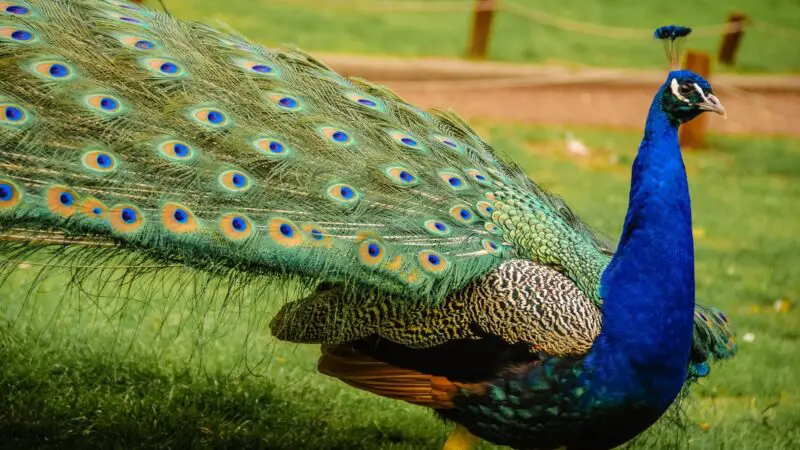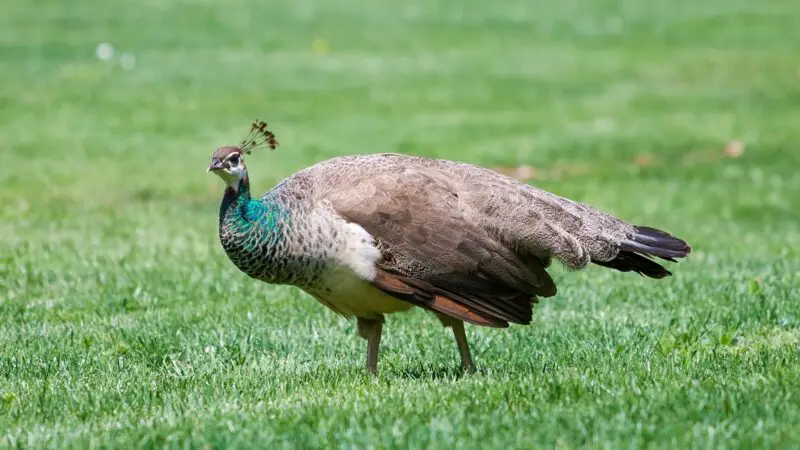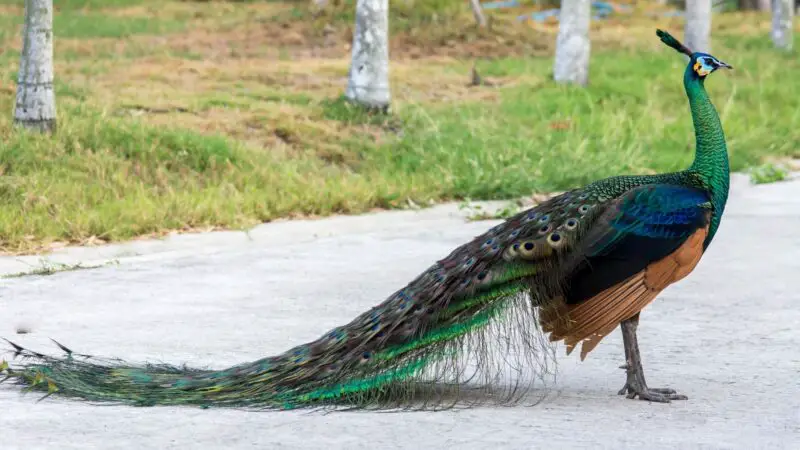Peacock is commonly depicted as a bird with feathers that have fascinating patterns and attractive colors. It’s not a misinterpretation, but it only refers to the male peafowl as its female counterpart is called a peahen.
This is one of the many factors that distinguish the male peafowl from the female. Other points are mentioned in this article.
What’s the difference between male and female peacocks? With the long tail of a male peacock that shows eyespots when opened into a fan, it’s straightforward to distinguish it from its female counterpart. Therefore, these beautiful birds are the right representation of sexual dimorphism because every gender of this species has distinct features.
The peacock’s tail is a prominent feature, so you can easily see it. However, there are other differences between male and female peacocks.
If you pay attention, you’ll know that size, color, behavior, and other body parts are distinct among male and female peafowl species.
What Do Male Peacocks Look Like?

The prominent features of male peacocks are their head crest and the long tail called train. The eyespots appear when the peacock is almost two years old, so the tail becomes striking.
Due to the five-foot length of the tail, a peacock is hailed as one of the largest birds. It has vibrant green and blue hues that make its appearance grander.
What Do Female Peacocks Look Like?

The female peacocks have the same head crest as the males. Their bodies are mostly brown with a green neck and white belly. The brown color is used for camouflage.
Male and Female Peacocks | A Detailed Comparison
Aside from the alluring long tail of a male peacock, there are other features that can help you differentiate it from the female peacock.
Behavior
Both male and female peacocks live in flocks when they’re in the wild. But you’ll readily notice that the male is solitary compared to the female. Behavioral differences happen during the breeding season, as male peacocks do the first move. They shake their wings and rattle their tails.
A male peacock would stay beside vegetation and put its tail in a semi-circular array to attract a female even from afar. There will be a fight between females, so one of them is chosen by the best male mate.
When it comes to child-rearing, the male doesn’t contribute to parental care. The female peacock incubates the eggs and makes the nests of the babies.
Colors
The color difference is apparent. The male peacocks have a gleaming blue color to attract females. It’s easy to distinguish the toned-down plumage of the female peacocks. Most of their feathers are brown, cream, and gray.
Even the belly of males is blue while it’s white on the females. When compared, females are less attractive than males. But the peahen’s color has an advantage since it can help her camouflage in the wild.
Size
The average length of the male is 7.5 feet, while the female is just around 3.5 feet. These measurements include their tails. When it comes to weight, the male is heavier since it can be 9 to 13 pounds. The female peacocks can weigh from 6 to 9 pounds.
Tails
In terms of tails, the comparison is focused on length and color. The tail of male peacocks can range from 2 to 5 feet. It showcases various colors as well. There’s even a study conducted by the staff of The University of Akron that this colorful tail can spark ideas of developing vivid hues on TVs, tablets, computers, and cosmetics.
The tail comprises 60% of the male’s length. On the other hand, the female peacock has cream and brown colors on its tail. Even though they can both erect their tails, the meanings are different.
For male peacocks, it’s done for courtship. Female peacocks do it as a sign of aggression with the impulse to fight for a potential mate or protect their young.
Heads and Crests
You’ll find short, curly feathers on a male’s head that is topped with a fan-like crest that has blue, tiny feathers and long shafts. The crest on the female peacocks is brown.
Legs and Spurs
Since male peacocks are larger than female ones, it follows that they have longer legs. They both have spurs on their legs but the growth is earlier among males. Female spurs are blunt and shorter than males. Their legs are used in protecting their territory.
Why Are Male Peacocks Prettier?

Male peacocks are prettier because of the blue and green color of their feathers. They especially look stunning when the tail is spread open and the eyespots are exposed. Female peacocks don’t have this majestic tail.
How to Tell if a Baby Peafowl Is Male or Female?
It’s hard to tell whether a baby peafowl is male or female. The beautiful tail of a male peacock develops when it’s three years old. However, it’s believed that those with long legs and colorful feathers are males.
You can identify in advance the gender of the peafowl by its spurs. This body part grows earlier in males than females. But it sometimes doesn’t grow on peahen.
Frequently Asked Questions
What Are Peacocks Good For?
For Eggs and Meat
Peahen eggs are nutritious and taste like chicken eggs. A female peacock can only produce an average of 20 eggs per year, so it’s expensive and sold for $25 to $100 apiece. Although peacock meat is not commonly consumed in the US, some Asian countries, as stated in the study entitled ‘The Peacock Cult in Asia’.
Like Watch Dogs
Nothing can get passed through peafowls as their senses are similar to watchdogs. Regarding this matter, they can help with pest control by eating amphibians, rodents, snakes, and various insects.
Are White Peacocks Male or Female?
White peacocks can either be male or female. They only have the condition called leucism, which blocks the pigment from adhering to the feathers.
What Country Are Peacocks Native to?
Peacocks are native to India and Sri Lanka. However, these avian species are widespread in Assam, Burma, Ceylon, Congo, Java, Kashmir, Malaya, Nagaland, Nepal, and Pakistan.
Are Peacocks Aggressive?
They’re aggressive because they’re territorial. The female is particularly aggressive as it can attack someone who gets near its nest. A male peacock can attack other males when it wants the peahens only for himself.
These birds rarely attack humans, but there is news about zoo incidents. Some peafowls pecked or scratched some children.
Should Peacocks Be Kept as Pets?
You can keep peacocks as pets as long as you can deal with their behaviors. You’ll spend more time cleaning when you have them on your farm because they discharge a lot of poop.
They can be loud, and although you would typically hear them in the morning, they can be noisy at night. Hence, those who are light sleepers will be bothered.
Peafowls also consume plants. So, they’ll also eat the plants in your yard. This is something that won’t make you happy. On the brighter side, peacocks are not picky, and they’re like chickens that eat varieties of food.
It’s best to get the peafowls that are approved by the United Peafowl Association.
How Much Is It to Buy a Peacock?
The cost of adult peacocks can range from $35 to $300. The bird’s condition affects the pricing, and rare species can cost up to $1000. You can opt for eggs and chicks for a lower price, which is from $10 to $100.
The cost also depends on your source or where you purchase the birds. It varies because there are different species.
1. Java Green and Subspecies
- Java Green – Around $2000
- Spalding peacock – $75 to $150
2. Indian Blue and Color Mutations
- Pure Indian Blue – $1355 per chick that is eight-day-old (non-sexed); $650 for a breeding pair (2 years old); $525 for a pair of yearlings
- Blue peafowl – $50 to $75 per bird
3. White Peafowl
- Standard White – $200 to $250 each; $650 to $750 for every breeding pair
4. Black-shouldered
- Pure breed – $50 to $100 each
- With color mutation – $200 to $1000 each
5. Cameo
- $200 to $250 per bird; $600 to $700 for every breeding pair
6. Violette (Rare Peafowl Species)
- $1,000 for every breeding pair
Summary
Since the colorful and magnificent tail of the peacock grabs everyone’s attention, it’s the very first thing that you can point out when citing the difference between the male and female peafowls.
Their colors, size, spurs, and behavior are other determiners when comparing the two species. All in all, peacocks are larger and more attractive than peahens.
